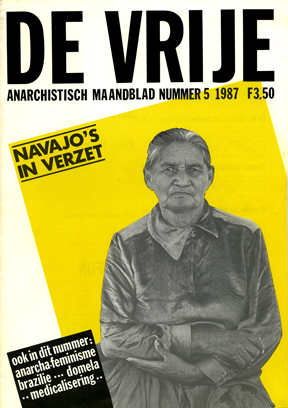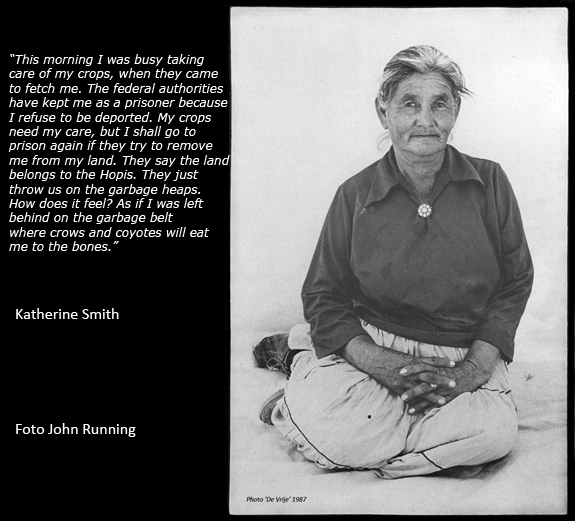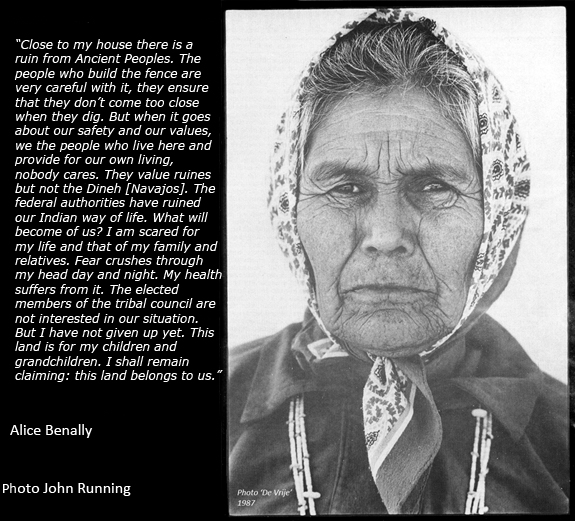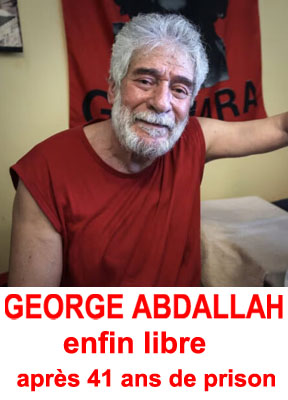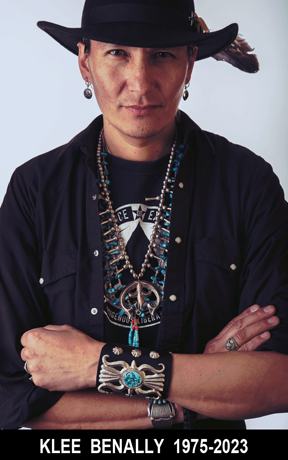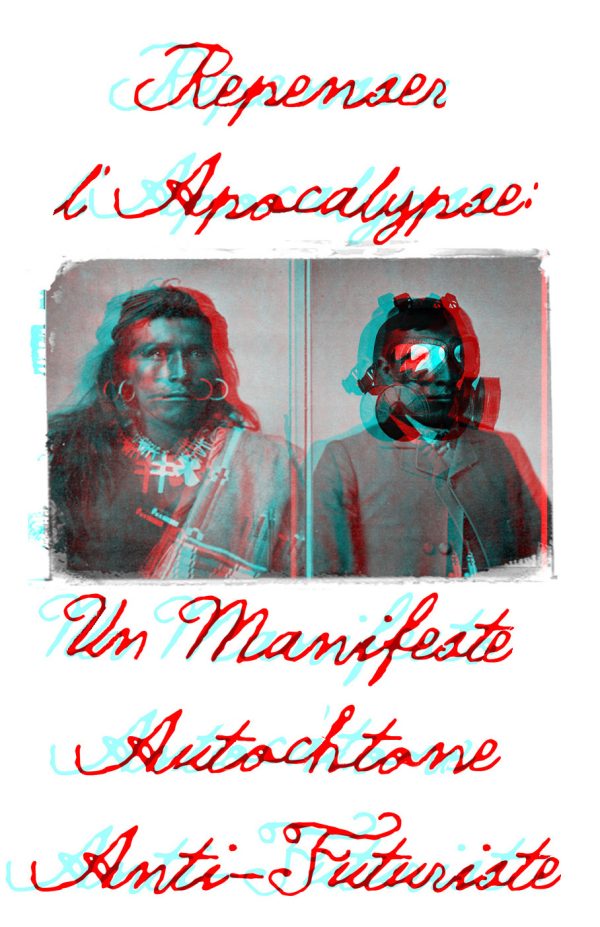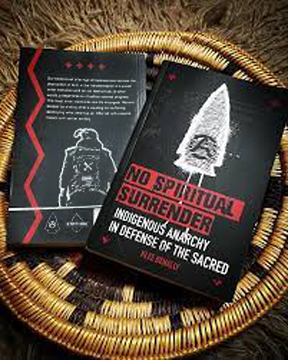DE VRIJE
ANARCHIST MONTHLY PUBLICATION, ISSUE NUMBER 5, 1987
NAVAJOS RESISTING
Against Deportation To Radioactive Promised Land
In De Vrije’s issue of August last year, the background of the deportation plan of a large group Navajo Indians who live above ground containing minerals worth billion dollars, has been extensively described. As the war expected to break out on July 6th 1986 between the American army and the unbending Indians did not occur, silence has fallen in the media about Big Mountain. The author of this article, who just came back after spending several months on the reservation, shows that shocking events are still taking place over there. For instance, the new ‘thuislanden’ [literally ‘homelands’, but the word ‘thuisland’ had become characteristic of Apartheid South Africa] reserved for the Navajos turn out to be heavily polluted by radioactivity, as a consequence of an environmental disaster [Church Rock, NM].
The warm Southwest of the United States is going through a quick development. The fast growing cities in the ‘Sunbelt’, with their high-tech industries, their military companies and bases, need cheap power. The developers have spotted out a large portion of Indian land in the Northeast of Arizona which has been used jointly for centuries by two tribes, the Hopis and the Navajos. In the middle of this territory – about which someone ever remarked that you could nowhere be so far from the United States and still inside – lies Big Mountain, which is sacred for Indians. Geological research in the 1950s showed that Big Mountain stands above billions of tons of easy to extract coal. However, the huge excavators can only be brought there if the Indian inhabitants leave. Those are very traditional Indians, many of whom still live according to their old cultural customs. “Who leaves disappears” they say, especially the older people, who feel strongly bound to their land and Mother Earth. They won’t leave voluntarily; a mass deportation is thus necessary. Air conditioners against recalcitrant, backward Indians.
If you call the public information service of the BIA, or talk with a press relations officer of Peabody Coal Company, you will get to hear strong denials if you suggest that greed for electricity produced by coal power plants is the underlying reason why hundreds of Hopi and tens of thousands of Navajos should leave their lands. But the Indians involved know better. A particularly obscure network, in between called the “Mormon connection”, in which, apart from Indians brought up in Mormon boarding schools, Mormon lawyers, members of Congress and mining companies play a key role, has devised a powerful trick to divert public attention. Through their efforts both the general public and the American government have been brought to believe that the moving of so many Indians has been made necessary to prevent a tribal war between Hopis and Navajos.
A few tips out of the manual of modern land theft. Suppress the word deportation, and replace it by ‘relocation’. Keep secret the real motives, but depict the Navajos as blood thirsty, wild people who want to bury in the ground the peaceful Hopis. Deny any difference between the westernized Indians members of tribal councils imposed by the American government, en de traditional Indians who don’t want to have anything to do with that pseudo-democratic form of leadership. Divide the common use area with barbed wires in two halves – one for the Hopi and one for the Navajo tribal councils, so that those can lease the land to mining companies. Clear the land as much as possible from Indians by forcing those who live at the wrong side of the fence to move elsewhere. Put up an official relocation commission to guide the realization of the project as humanly as possible. Let everybody know that the Indians involved will be largely compensated for any loss. Be sure that compliant media will repeat the tribal war story without asking any further questions. Thus the Mormon connection seems to have all the trumps to perform a perfect magic trick. But does it go so smoothly in reality?
ALCOHOLISM AND SUICIDE
July 6th 1986 is the last day, for the Indians living on the wrong side of the barbed wire, to leave ‘voluntarily’. It concerns thousands of Navajos who have remained; the hundred Hopis have already left the land given to the Navajo tribal council. Many people fear that, after the deadline, the National Guard will use violence to remove the stubborn ones from their land. And it could lead to a bloodbath: hundreds of Navajos have announced that they will NEVER leave. In between it has become clear for more and more people how disastrous the consequences of moving have been until now. 25% of the people who have moved have already died of alcoholism, suicide and other causes linked to the relocation. Statistics make clear, though hyper mobile Americans can hardly imagine it, that moving, for those traditional Indians, literally means death. It is likely that because of the national and international attention raised by the case in the summer of 1986 – when the ultimatum expired three foreign film teams were present – the National Guard has not intervened yet.
At the moment, more than a half year later, a lot of that attention has subsided. Only the imminent threat of a confrontation, as it existed last summer, was interesting enough for the media. In between, however, the relocation operation has been going on, slowly but uninterrupted. And hundreds of families still refuse to leave the land where they were born and were their navel string is buried. First manipulation and exhaustion is tried. In the end the BIA (a branch of the Interior ministry) helped by law enforcement agents enacts the transport of the people.
In the winter of last year, it became clear to the American Congress that the moving operation had to be somewhat improved. Many Indians who had moved to small towns on the border of the reservation had already lost their houses to crooked real-estate speculators. Moreover, Congress ruled that the process of absorbing the people was also unsatisfactory. ‘Accompanying social measures’ were necessary and new houses should be built to house Indians closer to the Navajo reservation. The BIA bought about 1500 sq. kilometers of land for that purpose. Those so-called ‘New Lands’ were at the southeast border of the Navajo reservation. This spring prefab houses would arise from the ground in three months. The commission wants to increase the tempo of the relocation. At present, with about one family moving each work day, it goes much too slow. At that pace, commission members will be retired long before the relocation is completed. Some numbers. When the ultimatum expired in the summer of 1986, only 40% of the concerned families had moved, that is thousand out of 2600 families. In the rest of the year over hundred more will follow. The relocation commission considers that an average family comprises 4.5 members. In the words of the commission, those people have moved voluntarily. However, the ‘voluntary’ character of the moving can be doubted when you consider that, as a consequence of the relocation law, those Indians had to give up 90% of their cattle, were not allowed to build anything new or to do any repairs to existing shelters or houses. Add to this that the law was passed in 1974, and that Navajos much depend on sheep for their living, and you will understand that it could not have happened without pressure.
NOBODIES
As said above, there are few hundred families who will never be intimidated and leave. One of the recalcitrant Indians, Pauline Whitesinger, discovered that her name appears, without that she knew about it, on a list of people who have applied for a moving premium. The authorities keep minimizing the problem doing as if it concerned only a few related families on Big Mountain. The truth is that nobody really knows how many people are still in the area now, despite of the expiring of the ultimatum. Roughly, you can distinguish the following groups: first the Navajos who have announced publicly that they will never move, and those who also resist deportation but do not claim it. Then there are those who ‘want’ to move but for whom there is no housing available. Further, many Indians have left their house of origin and have been wandering around ever since. And from those who have in between been convinced to move, appear about thirty percent not to be found anywhere: they could not stabilize in their new situation. Finally, there is a group of unknown size of ‘nobodies’: people who have not been identified yet by civil servants and do not appear in any statistics. It is no surprise that Big Mountain support groups call not to take part in any government game about what is the exact number of resisters against the relocation. Each family, each individual who is deported is one too much.
Let’s go back to the ‘New Lands’, the Promised Land to where the exodus should lead. The newly appointed ‘counselors’, a kind of social gentlemen council, must stimulate – in a friendly but forcible way – the people to move after all. They have not yet dared to show themselves at the most radical Navajos’. Practically nobody wants to go to the new ‘thuislanden’ [homelands], even when lured by tricks such as promising that who comes first may choose the best piece of land. The new houses are built in a kind of Soweto ghetto style, in total opposition with the scattered way of living in the traditional hogans.
There is one more reason not to move to the New Lands. Part of the New Lands lies in the basin of the Puerco River. In 1979 a dike enclosing a mud pool of uranium mining waste broke. This was the biggest environmental disaster in the history of the United Sates. Radioactive waste and very poisonous heavy metals came into the Rio Puerco in large quantities. But as it happened here, in a remote area where only Indians live, it did not draw much attention. After the breaking of the dike signs appeared along the Rio Puerco reading that water was unsafe for both humans and animals. In 1985 some measurements have been carried out in the river water near Chambers, a small place that now lies in the middle of the New Lands. The result was that it contained 1500 picocurie per liter which is fifty times more than the officially tolerable maximum. From the twenty-one sources now used by communities, half receive water from underflows of the Rio Puerco. The water of these sources is in many cases radioactive.
MAC DOLLARS
How does the case look politically in between? In November 1986 there have been Senate elections in the United States. The Democrats got a majority and the chance that Washington withdraws the relocation law is a little less small. An important character in the whole moving operation, Barry Goldwater, leaves the stage. The extreme rightist Senator of Arizona, who one year ago was still claiming that, if necessary, he would personally help the National Guard to remove the Navajos, is now retired.
In the same month of November there were also elections in the Navajo reservation. Unfortunately, Peter MacDonald was elected chairman of the tribal council, be it with a tight majority. This man, who has already been chairman in the 1970’s and in January 1980, got the nickname Mac”Dollar”. At the time, he was supposed to be the richest Indian in the world and he might still be. Lured by his attractive conditions, many coal and uranium mining companies have settled on the reservation. Peabody Coal, for instance, pays only 15 cent for each ton of coal it extracts. When entering into agreements, MacDonald always managed to get royalties and bribes for himself. It is frustrating that such a thoroughly corrupt character is elected again after a four years break. An aspect which must have played a major part is the fact that he radically campaigned against relocation. Many Navajos had got fed up with the useless attempts of MacDonald’s predecessor, Peterson Zah, to find a workable compromise.
As a true populist leader, MacDonald knows much better how to play with emotions. It goes like this: we Navajos are a proud people. We won’t let the Hopis teach us; nobody can walk over us, etc. It is clear that for the money loving MacDonald the enemy is not in Washington, but in the building of the Hopi tribal council. And in that building, they are naturally delighted about the new Navajo leader. The members of the Hopi tribal council, most of whom have been educated in Mormon boarding schools and also speculate on economical improvement, thankfully accept the challenge. Now at last those aggressive Navajos reveal their true nature, the government must move those people somewhere else, otherwise we, a numerically much smaller people, shall be crushed. The difference between ‘traditionalists’ and ‘progressives’ shows again. The ‘progressive’ Indians who come back to their homeland, after a long career outside, to become member of a tribal council, for instance, or to sell out the land on which they were born, are totally alienated from the Indians who don’t want to hear anything of those interferences from outside.
On the Hopi reservation, only a very small minority shows up for the tribal council elections. The others stay at home as a protest and do not get involved with that circus. But then, the tribal council set up according to Western model decides about what happens on the reservation. A majority of the Navajos does take part in the elections. The political leaders know how to attract people to elections meetings by offerings free meals. Many Navajos vote according to their clan relationship with the candidate. MacDonald has, from that point of view, the advantage of belonging, through his parents, to two of the biggest clans on the Navajo reservation.
FILIBUSTER TACTIC
In those last elections there is, however, a glimpse of hope: Larry Anderson, member of the American Indian Movement (AIM), has been elected to the tribal council. When MacDonald previously was chairman he had this activist thrown into jail several times. Among others, it happened when Anderson and other AIM members came to help the heavily exploited women working at a Fairchild semi-conductors factory and undertook an armed occupation of the place. The irony is that this action caused the AIM to lose a lot of support from Navajos, as Fairchild found the situation to hot and moved to the ‘third world’. This meant that an important source of jobs had gone.
Larry Anderson will defend, if necessary with his life, the people who refuse to move. However, the question is if he can do much in the tribal council. He already announced that he would not hesitate to use the ‘filibuster’ tactic. This means that a speaker in the council keeps talking so long about a subject that it becomes impossible to take a decision.
The coming months will be decisive, as well for the moving operation as for the resistance against it. The tactic of the government might be to declare the moving operation ‘completed’ as soon as the ghettos in the New Lands are built. Then they could incite some Hopi ranchers against the Navajos, encourage them to go with their flocks to the areas where the still recalcitrant Navajos are, as for instance in and around Big Mountain. The inevitably ensuing tensions would increase the pressure on the Navajos to leave their land. And the pushed forward Hopis could demand for external help. But still, the possibility of mass deportations, as the building of new houses on the New Lands is almost completed, is certainly not unthinkable.
DIRECT ACTIONS
First, the support groups try to move the newly elected Congress to withdraw the relocation law or at least to pronounce a moratorium on new deportations. So there could be a possibility for the Hopis and Navajos to come to an understanding, preferably outside the tribal councils. This is very much needed after years of being victims of the divide and rule tactic. Along with that lobbying in Washington, there are attempts to have the law declared void on the basis that it constitutes a violation of traditional Indians’ religion. Freedom of Religion is guaranteed by the First Amendment of the American Constitution.
Some more radical groups do not want to wait and see if the juridical game and the lobby campaign might get the law withdrawn. They advocate suppressing the law with words and deeds: on the one hand by organizing hard actions against the involved companies (among others Peabody Coal, Bechtel Corporation, Boeing), on the other hand by giving the Indians who want to stay the actual possibilities to do so. It could be done, for instance, through work brigades (forbidden by the relocation law) repairing existing hogans and building new ones. Another possibility is to bring sheep from outside to replace those that have been confiscated. The support group in Berkeley organizes a form of economical help in which traditionally woven clothes are bought and then sold for a fair price. With the money earned, more clothes are bought.
But those direct actions can also bring major disadvantages. For instance, it can sound good to repair existing dwellings and build new ones, but will the building teams be there too if the Indian families get harassed by patrolling police later? And won’t the alternative ‘idealistic import’ of clothes create a new dependence, in the sense that people will expect a guaranteed flow of goods, which might subside when the commotion about the events is over? Moreover, that kind of help can easily create frustration on the reservation in the style of: it’s always the same people who get help, or: there will always be something fishy afterwards [i.e. some people will manage to get some bribes].
LOW FLYING PILOTES
Once more appears from that kind of embarrassing questions that we have to do with an Indian culture which is totally different from ours. The people from Big Mountain never had much to do with money, media or the presence of Whites showing solidarity. After all the interferences from government civil servants, counselors, Indian police, low flying military jets pilots, anthropologists, missionaries, and now a group of sympathizing outsiders, those Indians want to be left alone at last.
During several meetings, the Ancients from the Hopi and Navajo tribes have let us know: you are white, you speak English. The government in Washington is white too. We do not understand that law they made there. If you want to help us, you know better what has to be done against it. A different, not necessarily less radical strategy for the support groups would be to develop as little activities as possible on the reservation and concentrate all attention on the power centers, thousands of miles away, where the destiny of those people is decided.
JAN

